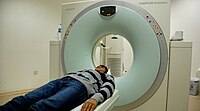
Photo from wikipedia
The US Preventive Services Task Force (USPSTF) issued updated guidance for lung cancer screening using low‐dose computed tomography (LDCT) in March 2021, which expanded the eligibility criteria to include adults… Click to show full abstract
The US Preventive Services Task Force (USPSTF) issued updated guidance for lung cancer screening using low‐dose computed tomography (LDCT) in March 2021, which expanded the eligibility criteria to include adults aged 50–80 years (previously 55–80) with a 20+ pack‐ year smoking history (previously 30+) who currently smoke or have quitwithin the past 15 years. The impetus for the reevaluation of their prior guidelines was multifaceted. First, the publication of the Nederlands‐Leuvens Longkanker Screenings Onderzoek (NELSON) trial in 2020 found that interval LDCT substantially reduced lung cancer mortality compared to no screening at 10 years of follow‐up among a cohort of mostly males (risk ratiomales, 0.76; 95% CI, 0.61– 0.94) with lighter smoking histories and younger ages (vs. participants in the National Lung Screening Trial [NLST]). In fact, only 50% of the participants in NELSON would have met the eligibility criteria for NLST. Additional contributing factors include the disproportionate number of racial/ethnic minority and female patients with lung cancer unable to qualify for screening under the 2013 USPSTF eligibility criteria and simulation model results showing that screening with a lower pack‐year smoking threshold and a younger starting age would increase the number of eligible screening candidates, avert more lung cancer deaths, and result in more life‐years gained. Given the larger volume of screening candidates expected using the new criteria, simulation models found that overdiagnoses, false‐positive test results, and radiation‐related lung cancer deaths would rise and the number needed to screen (NNS) to save one life would increase. It should be noted, however, that the NNS for lung cancer screening remains far lower than for colon, cervical, and breast cancer when modeled under similar follow‐up periods. Although the 2021 USPSTF recommendations increase the number of women and persons from racial/ethnic minority groups who qualify for screening (i.e., a 97% increase among non‐White individuals, 78% among White individuals), a study using data from the 2015 National Health Interview Survey found that the new criteria actually performed better for White individuals than for their non‐ White peers. In fact, although life‐years gained and preventable deaths improved among non‐White populations, disparities widened between White and non‐White populations (i.e., gains in life‐years were more dramatic for White populations). With the limited data now available, it remains unknown whether modifying the screening eligibility criteria to include lower risk populations will prove effective across diverse populations in the real world. Therefore, it is important to consider the perspectives of a variety of stakeholders who bring different skills, backgrounds, and experiences to the table. In this commentary, we discuss themes that arose when we solicited input on this important topic from lung cancer screening experts and members of the National Lung Cancer Roundtable (NLCRT) in April 2021, approximately 1 month after the USPSTF released their newest guidance.
Journal Title: Cancer
Year Published: 2023
Link to full text (if available)
Share on Social Media: Sign Up to like & get
recommendations!